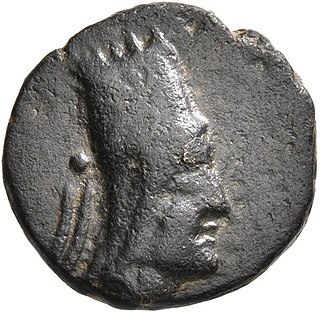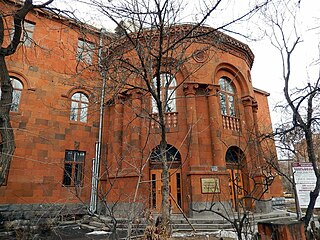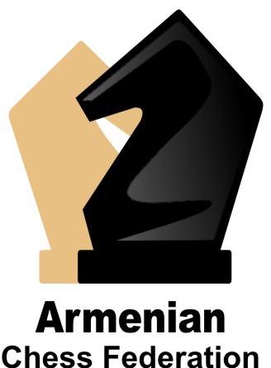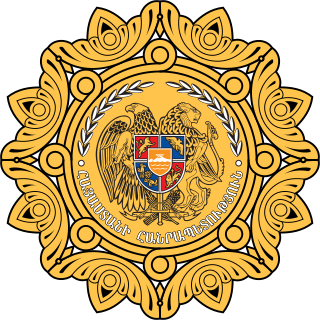
The politics of Armenia take place in the framework of the parliamentary representative democratic republic of Armenia, whereby the president of Armenia is the head of state and the prime minister of Armenia the head of government, and of a multi-party system. Executive power is exercised by the president and the Government. Legislative power is vested in both the Government and Parliament.

Gregory the Illuminator was the founder and first official head of the Armenian Apostolic Church. He converted Armenia from Zoroastrianism to Christianity in the early fourth century, making Armenia the first state to adopt Christianity as its official religion. He is venerated as a saint in the Armenian Apostolic Church and in some other churches.
The Armenian nobility was a class of persons which enjoyed certain privileges relative to other members of society under the laws and customs of various regimes of Armenia. Governments which recognized or conferred nobility were the Kingdom of Van, Satrapy of Armenia, Kingdom of Armenia, Bagratid Kingdom of Armenia (885–1045) and the Armenian Kingdom of Cilicia (1198–1375). The Armenian kingdoms of Vanand (963–1065), Syunik (987–1170), and Lori (978–1113) had a system of nobility that was similar to the nobility of Cilicia.

Vahagn or Vahakn, also known as Vahagn Vishapakagh, is a warrior god in Armenian mythology. Scholars consider him to be either the thunder, or sun and fire god of the pre-Christian Armenian pantheon, as well as the god of war, bravery and victory. He formed a triad with Aramazd and Anahit. Vahagn is etymologically derived from *Varhraγn, the Parthian name for the Indo-Iranian god Verethragna, although there are key differences between the two deities.

Armenian mythology originated in ancient Indo-European traditions, specifically Proto-Armenian, and gradually incorporated Hurro-Urartian, Mesopotamian, Iranian, and Greek beliefs and deities.
The Arsacid dynasty, called the Arshakuni in Armenian, ruled the Kingdom of Armenia, with some interruptions, from 12 to 428. The dynasty was a branch of the Arsacid dynasty of Parthia. Arsacid kings reigned intermittently throughout the chaotic years following the fall of the Artaxiad dynasty until 62, when Tiridates I, brother of Parthian King Vologases I, secured Arsacid rule in Armenia as a client king of Rome. However, he did not succeed in establishing his line on the throne, and various princes of different Arsacid lineages ruled until the accession of Vologases II, who succeeded in establishing his own line on the Armenian throne, which ruled the kingdom until its abolishment by the Sasanian Empire in 428.

Tigranes I was an Artaxiad king of Armenia at the end of the 2nd and the beginning of the 1st century BC. Few records have survived about his and his predecessor Artavasdes I's reign, which has led to some confusion. Some modern scholars have doubted that such a king reigned at all. Other historians, such as Hakob Manandian, David Marshall Lang and Rouben Paul Adalian consider him a real figure but differ or are uncertain on the exact dates of his reign. Although it has been proposed that Tigranes I reigned from 123 BC to 96 BC, this view has been criticized. Another suggestion is that Tigranes I ruled in 120 BC - 95 BC and this has been recently corroborated by historian Christian Marek.
The Orontid dynasty, also known as the Eruandids or Eruandunis, ruled the Satrapy of Armenia until 330 BC and the Kingdom of Armenia from 321 BC to 200 BC. The Orontids ruled first as client kings or satraps of the Achaemenid Empire and after the collapse of the Achaemenid Empire established an independent kingdom. Later, a branch of the Orontids ruled as kings of Sophene and Commagene. They are the first of the three royal dynasties that successively ruled the antiquity-era Kingdom of Armenia.

The Writers' Union of Armenia was founded in August 1934, simultaneously with the USSR Union of Writers and as a component part of the USSR Union.
Astłik was the Armenian goddess of fertility and love, and consort of Vahagn. In the later pre-Christian period she became the goddess of love, maidenly beauty, and of water sources and springs.

Armenia–Hungary relations refer to bilateral relations between Armenia and Hungary. Armenia is represented in Hungary through its embassy in Vienna, Austria, and an honorary consulate in Budapest, Hungary. Hungary is represented in Armenia through its embassy in Tbilisi, Georgia, and an honorary consulate in Yerevan, Armenia.

The Chess Federation of Armenia, also known as the Armenian Chess Federation, is the governing chess organization in Armenia and is affiliated to FIDE. The body was founded in 1927. Responsible for organizing individual and club championships for men and women and the various important international tournaments in Armenia, it also forms the Armenian national men's and women's teams. The Federation is a member of the European Chess Union.
Vahe sometimes Vahé is a given name in Armenian.

The president of Armenia is the head of state and the guarantor of independence and territorial integrity of Armenia elected to a single seven-year term by the National Assembly of Armenia. Under Armenia's parliamentary system, the president is simply a figurehead and holds ceremonial duties, with most of the political power vested in the parliament and prime minister.

Vahagn Garniki Khachaturyan is an Armenian politician who is the 5th and current president of Armenia. He served as Mayor of Yerevan from 1992 to 1996 and as the Minister of High-Tech Industry from 2021 to 2022.

The Armenian Native Faith, also termed Armenian Neopaganism or Hetanism, is a modern Pagan new religious movement that harkens back to the historical, pre-Christian belief systems and ethnic religions of the Armenians. The followers of the movement call themselves "Hetans" or Arordi, meaning the "Children of Ari", also rendered as "Arordiners" in some scholarly publications.
Vahagn Militosyan is an Armenian professional footballer who plays as a striker.
Vahagn Hayrapetyan is a jazz pianist, singer and composer.

The Atabekians are an Armenian Princely (Meliqly) house of Lords of the Jraberd principality (Meliqdom) in Artsakh, which ruled in the 19th century. The most renowned representative of this family was Prince Hovhannes (Vani) Atabekian, Prince of Jraberd, who took an active part in the Russo-Persian War (1804–13).
Events of the year 2022 in Armenia.











